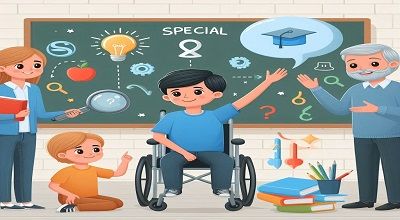Special Education
Special Education refers to the tailored educational services and programs designed to meet the unique needs of individuals with disabilities. These disabilities can encompass a wide range of conditions. Including learning disabilities, developmental disabilities, emotional and behavioral disorders, physical disabilities, sensory impairments, and more.
The primary goal of SE is to provide these individuals with the necessary support, and accommodations. And interventions to help them access education and achieve their fullest potential. This often involves creating an Individualized Education Plan (IEP) or a similar personalized plan. That outlines specific goals, strategies, and services to address the student’s individual needs.
Special education can take place in various settings. Such as mainstream classrooms with additional support, separate SE classrooms, and resource rooms. Or even through a combination of both. The services provided can include modifications to curriculum and instruction. Specialized teaching methods, assistive technology, speech and language therapy, occupational therapy, physical therapy, counseling, and more.
It’s important to note that the approach to special education varies from one country to another. Even within different regions or school districts. Laws and regulations, such as the Individuals with Disabilities Education Act (IDEA) in the United States. Govern how SE services are provided to eligible students. The aim is to ensure that individuals with disabilities receive an equal opportunity for education. And are supported in their educational journey to the greatest extent possible.
Advantages & Disadvantages Of Special Education
Advantages of SE:
- Tailored Support: Special education provides individualized support. And accommodations to students with disabilities, allowing them to access education in a way. That meets their unique needs and learning styles.
- Inclusive Learning: When implemented effectively. SE can promote inclusion by integrating students with disabilities into mainstream classrooms. Fostering a diverse and accepting learning environment.
- Personalized Goals: Individualized SE Plans (IEPs) or similar plans allow for specific educational goals. And strategies to be established for each student. Ensuring their progress is monitored and adjustments are made as needed.
- Specialized Instruction: SE teachers are trained to use various teaching strategies. Methods to cater to the diverse needs of students. Which can lead to more effective learning outcomes.
- Skill Development: SE programs often focus not only on academic skills. But also on the development of life skills, social skills, communication skills, and independence.
- Improved Self-Esteem: Successful experiences in a supportive environment can boost the self-esteem and self-confidence of students with disabilities. Helping them develop a positive self-image.
Disadvantages of Special Education:
- Stigmatization: Students in special education programs may feel stigmatized. Or isolated due to being separated from their peers in mainstream classrooms. Potentially leading to feelings of inadequacy.
- Limited Social Interaction: In some cases, students in SE programs. May have limited opportunities for social interaction with their non-disabled peers. Which could affect their social development.
- Resource Allocation: Special education can be resource-intensive, requiring additional funding, specialized teachers, and support staff. Which might strain the resources of educational institutions.
- Labeling and Stereotyping: The categorization of students into SE programs can lead to labeling and stereotyping. Which might not accurately represent a student’s potential or abilities.
- Teacher Training: Educators in SE need specialized training to effectively address the diverse needs of students with disabilities. Lack of proper training can impact the quality of SE provided.
- Inclusion Challenges: While inclusive education is a goal. Integrating students with severe disabilities into mainstream classrooms can present challenges related to meeting their unique needs. And ensuring a conducive learning environment for all students.
- Balancing Individual Needs: Balancing the need for individualized support with the goal of integrating students. With disabilities in mainstream education can be complex and requires careful planning.
It’s important to recognize that the effectiveness of SE depends on various factors, including the quality of programs. The commitment of educators, the support of families, and the broader societal attitudes towards individuals with disabilities. Striving for a balance between meeting individual needs. And promoting inclusion is key to providing a well-rounded education for all students.
FAQS
Now here are some frequently asked questions (FAQs) about special education:
What is special education?
SE refers to educational services and programs designed to cater to the unique needs of individuals with disabilities. Ensuring they have equal access to education and opportunities for academic and personal growth.
Who qualifies for SE?
Individuals with disabilities, ranging from learning disabilities to developmental, emotional, or physical disabilities, may qualify for SE services. Eligibility is determined through assessments and evaluations.
What is an Individualized Education Plan (IEP)?
An IEP is a personalized plan developed for students with disabilities. Outlining their educational goals, required services, accommodations, modifications, and progress monitoring strategies.
What are some common disabilities addressed in SE?
Disabilities addressed in SE can include. But are not limited to learning disabilities, and autism spectrum disorders. And attention deficit hyperactivity disorder (ADHD). Intellectual disabilities, physical disabilities, and emotional/behavioral disorders.
How are SE services provided?
Special education services can be provided in various settings. Such as inclusive classrooms with additional support, separate SE classrooms, and resource rooms. Or even itinerant services where specialists work with students in different environments.
What laws protect the rights of students with disabilities in education?
In the United States, the Individuals with Disabilities Education Act (IDEA) ensures. That students with disabilities receive a free and appropriate public education in the least restrictive environment. Other countries have similar laws and regulations.
What is the role of a SE teacher?
Special Education teachers are trained to provide tailored instruction and support. And accommodations to students with disabilities.
